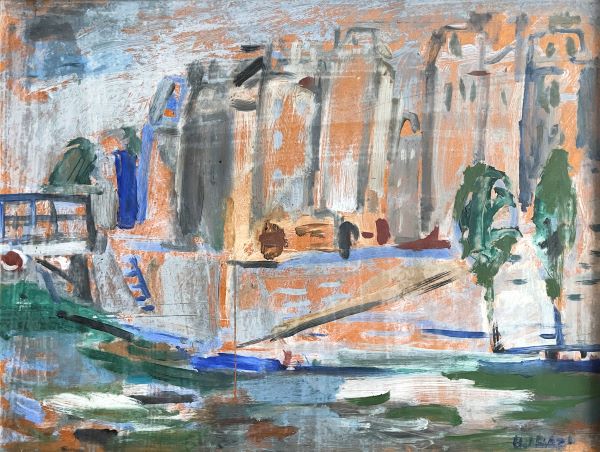Biography
Between 1960 and 1966, he was a student of the Hungarian Academy of Fine Arts, his masters: Bernáth Aurél, János Kmetty. He is the president of the Society of Székesfehérvár Artists, and also a member of MAOE, MKISZ, the Society of Hungarian Painters, the Society of Hungarian Water Painters, and the Szinyei Merse Pál Society. He has been exhibiting since 1967 and lives in Székesfehérvár.
In 1968 he visited Paris. He was on a longer study trip in Sweden, then with a scholarship in Rome. Already from the beginning of his career, he separated himself from the neo-avant-garde aspirations of young artists. He uses the naivety of graffiti, children's and cave drawings as his means of artistic expression. One of the main elements of his rich symbolism is water. Most of his diary-like paintings are dominated by humor and (self)irony, but also by melancholy. At the same time, he paints playful watercolors and large-scale board pictures, and even from the 70s onwards, he also creates box works, whose painted installations evoke the world of scale models of stage sets.
His paintings are mostly figurative, drawing calligraphy; however, his use of color (Garden in Nadapi I., 1997) testifies to the intensity of impressionism and expressionism. Its descriptive, narrative-like formal language is combined with a particularly light, almost weightless spatiality - often with multi-views similar to Egyptian depictions. The frame of his pictures does not close and hold them together, but opens them up and makes his works endless. He invisibly hides the center (one or more) of his paintings, drawings, compositions, as a focal point or focal point; thus, as the center of a kind of centrifugal force, it draws towards itself the often swirling motifs and streamlines. In his works, he associates figurality and abstraction. His favorite motifs are the labyrinth, well, cave, garden, tower, island, spring; the characters of his pictures are clowns, dwarfs, golems, winged figures, bugs; the location of the scenes is often the pub, the railway, the town, the village.
In 2000, a small monograph on his work so far was published with the study of art historian Márta Kovalovszky. In 2011, a two-volume catalog of his oeuvre was published. Péter Ujházi's life and more than three decades of artistic career are connected to Székesfehérvár. He was born in this city in 1940 and returned here after graduating from the painting department of the College of Fine Arts in 1966. In his narrative paintings seasoned with irony, the chronicle of history and everyday life is written at the same time. In the mid-seventies, the peculiar mapping of his pictures, assembled from several perspectives, almost inevitably leads the artist to the assemblage, the world of boxes, then in the eighties to the collaged, three-dimensional paper works, to leporellos, and then, turning to sculpture in the nineties, a grotesque is born ceramic panopticon.
Despite his essentially narrative artistic attitude, Ujházi was always attracted to landscape painting. The Nadap series of foliage pictures is an impressionistic landscape diary that started at the end of the sixties and continues to this day, with Nadap, a small village in the Velence Mountains, as its permanent location and source of inspiration.

